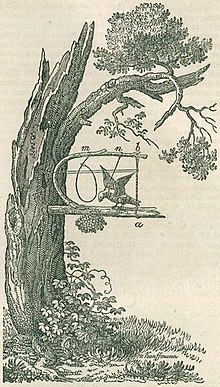Without
A Dohne is a snare that until the 20th century in Germany Birdtrap for catching of songbirds and snipe was used.
etymology
The word Dohne seems to be of Lower Saxony origin. Furthermore, the terms Maschenschleifen , Upper German cutting or Schneißen , tree dishes in the Rhineland and snirring in Lower Saxony were common. Similarly, the Dohnenstieg (also Dohnenstrich ) was called the Schnaid or Schnaat in Upper German . There is also hair .
Often, large numbers of drones were attached to the trees along a forest path . This is known as the Dohnensteig or Dohnensteig . This designation has been preserved as a field name in some places .
Design and functionality
Depending on the type of construction, a distinction is made between bast drones, iron drones or earth drones or running drones. In addition to small twigs, the materials used are mainly horse hair from tail and mane, but also linden bast and linen threads. The drones are attached to trees, "laid" or "placed". Rowan berries , but also other fruits, are used as bait .
The bird is lured by a bait, the noose is tightened and the bird is hanged, provided that it is not caught by the legs for hunting purposes . In contrast to other traps, drones are therefore only used to catch birds for consumption. Fishing gear such as horsehair snares and other traps are still used - mostly illegally - in various southern and western European countries. The flocks of juniper were the preferred target of the hunters . These birds were popularly known as Krammetsvögel .
Hunting law

"Catching birds with glue and snares" has been prohibited in Germany since 1908 in accordance with Section 2 I b) of the Birds Protection Act. Hunting was particularly widespread in the east of the German Empire , for example in East Prussia . During the First World War , when bird trapping to obtain food was temporarily allowed again, 20,755 birds were killed in a Dohnenstieg near Walkenried .
According to Section 19 (1) No. 5b of the Federal Hunting Act , bird lime and traps are prohibited.
literature
- Johann Georg Krünitz : Economic Encyclopedia , 1773-1858, s. Economic encyclopedia online
- Ilse Haseder , Gerhard Stinglwagner : Knaurs Großes Jagdlexikon , Augsburg 2000, ISBN 3-8289-1579-5
Individual evidence
- ↑ Dohnen Brockhaus Picture Conversations-Lexikon , Volume 1. Leipzig 1837, pp 579-580. Zeno.org , accessed February 7, 2020
- ^ Dohne, die Adelung, Grammatical-Critical Dictionary of High German Dialect , Volume 1. Leipzig 1793, pp. 1510–1511. Zeno.org , accessed February 7, 2020
- ↑ Haseder, p. 163
- ↑ barrel and socket ; Zeno.org
- ↑ Bird trapping with the Trapping Committee against Bird Murder , accessed on February 9, 2020
- ↑ Haseder p. 472
- ^ Alfred Hilprecht: Nightingale and Sprosser ( Die Neue Brehm-Bücherei ; Vol. 143). Westarp Wissenschaftsverlag, Hohenwarsleben 2004, ISBN 3-89432-185-7 (reprint of the Wittenberg 1965 edition).

